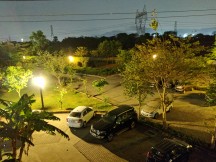OnePlus 9R hands-on review

Camera
The OnePlus 9R has a quad-camera system on the back. The primary camera is a 48-megapixel f1.7 IMX586 with OIS. The ultra-wide camera has a 16-megapixel sensor with f2.2 aperture. The remaining two are a 5-megapixel macro and 2-megapixel monochrome.

Unfortunately, while the hardware is undeniably identical to the OnePlus 8T, so is the software. One would think that perhaps OnePlus would carry over some of the UI changes introduced in the OnePlus 9 series to the 9R but that isn't the case.
While the app on the OnePlus 9 and 9 Pro isn't dramatically different, it does include some nice changes, such as a redesigned control wheel for making adjustments in Pro mode. Of course, since there's no Hasselblad branding on the 9R, you also don't get the orange shutter button, new shutter sound, and the 'OnePlus x Hasselblad' watermark.
Moving on to the image, the quality is also unchanged from the OnePlus 8T. With the main camera, you can expect reasonably good detail, dynamic range, and color performance provided you shoot outdoors under sunlight.
However, the issue with this camera is that the color performance can be very inconsistent in terms of accuracy, and it often takes a big hit indoors, especially under fluorescent lighting. You can expect some pretty big differences compared to what you're shooting and what the camera thinks it looks like.
For example, here's a scene with a bright red object on a bright yellow cloth under a cool LED light. The first image is actually a RAW image shot from the 9R and edited manually to represent the actual scene as closely as possible. The second image is what we got out of the Auto mode.



Edited RAW (9R) • Auto (9R) • Auto (9 Pro)
As you can see, the colors are rather off and this has been an issue with OnePlus phones for a while now. You can see in the third image shot from the OnePlus 9 Pro that this was rectified to some extent with the new color tuning but it's still not the same as the actual scene.
This scene is a bit of an extreme example but there usually is some color shift when shooting indoors. It's not something that is unsalvageable in post and as seen above, you can always just shoot in RAW and produce your own JPEGs from it. But that's a lot more work than what most people would want to put into their images.
Moving on to the ultra-wide camera, the images from this camera are not of great quality. The colors are even worse even in broad daylight and the images tend to look utterly lifeless when compared to the images from the main camera. The level of detail and dynamic range is pretty decent, however. The easiest way to improve this camera is to shoot in the vivid color filter within the camera app.
Speaking of color filters, the OnePlus 9R includes two new ones not found on the 8T or the rest of the 9 series. These are Night City and North California and made in collaboration with CD Projekt Red for Cyberpunk 2077. These are the same filters that were present in the Cyberpunk 2077 edition of the OnePlus 8T and somehow they made their way into this phone. These are pretty aggressively colored so while they may work in some instances they definitely don't work in all situations.












Standard vs Night City vs North California
The OnePlus 9R retains the monochrome camera from the OnePlus 8T. The 2-megapixel monochrome camera works with the 48-megapixel main camera to produce black and white images. This mode can be enabled by scrolling through to the final color filter called Mono.
As we have said several times in the past, the images this mode produces are nothing you can't make yourself with even a basic image editor. To think OnePlus expects you to believe that it needs a dedicated camera for this to happen and not that it's just there to pad the phone's spec sheet is laughable.
Finally, there's the 5-megapixel macro camera. The image quality is pretty decent provided there's enough light. However, the resolution is too low to get any real detail out of the images so the only real advantage of this lens is you can get closer than you can with the main camera. However, you can just shoot from further away and crop the image from the main camera, which can provide similar or even better results.
Moving on to low light, there's again no change compared to the OnePlus 8T. Low light images from the main camera often turn out usable even without using Nightscape, although they can get a bit soft. However, when the light gets too low, then you have to bring in Nightscape to salvage the situation.






Auto vs Nightscape main camera
For what it's worth, Nightscape often does a pretty good job. It's a bit overzealous, wherein it tends to overexpose the final shot, but at least you can see everything in the frame, including things your eyes couldn't.
Low Light performance on the ultra-wide, however, is pretty bad. Images without Nightscape are often unusable and even with Nightscape, the level of improvement isn't as dramatic as on the main camera.
Reader comments
- Sameera
- 31 Aug 2024
- IWR
I Don't recomand this model . After 14 months , my one plus 9R phone display got green & pink line issue.
- saju....
- 27 Aug 2024
- ITJ
i am using this phone from quite some time but there is problem with this device that without any reason i got some lines on my phone screen in green and pink color at it is very Ambar embracing thing for me
- Hatari
- 27 May 2023
- 7km
Last week onwards.. Unable to play any videos(Twitter/YouTube/Gaming etc) or audio (Spotify) without a 1-2 second freeze every 10 or so seconds. Hardware issue?
































